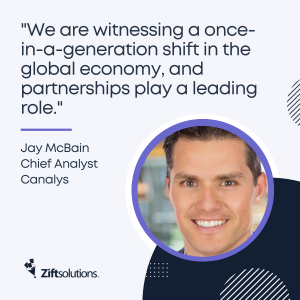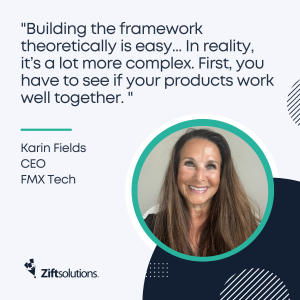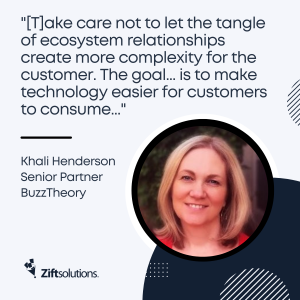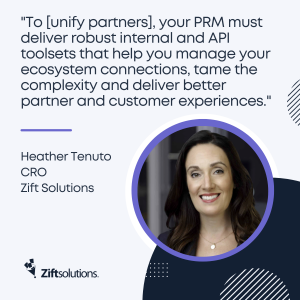- Successful partner ecosystem frameworks require a complete infrastructure.
- Executive-level buy-in is essential to developing and deploying an ecosystem partner framework.
- Internal and external sales compensation – vital to indirect sales business units – is more complex in partner ecosystem models.
- Successful partner ecosystems keep the customer business outcomes as their primary focus.
- Converting complex business processes into a simplified sales partner experience is vital to developing a thriving ecosystem.
- Ultimately, program success hinges on successful communications to, through and across the partnership ecosystem.
How Do You Build a Successful Partnership Ecosystem Framework?
Partner ecosystems are rising as technology vendors race to deliver comprehensive multi-technology solutions to their customers. IDC predicts that by 2026, 25 percent of the new application portfolio of global and local public, private and nonprofit organizations will consist of consortia-developed applications within their industry ecosystems.
 Jay McBain, Chief Analyst for technology market analyst firm Canalys, observes this global change in the adoption of the ecosystem model: “We are witnessing a once-in-a-generation shift in the global economy, and partnerships play a leading role. Most business leaders across every industry, of all size firms, and in every corner of the world are considering significant business model shifts. They are realizing that they can’t do it alone in the decade of the ecosystem.”
Jay McBain, Chief Analyst for technology market analyst firm Canalys, observes this global change in the adoption of the ecosystem model: “We are witnessing a once-in-a-generation shift in the global economy, and partnerships play a leading role. Most business leaders across every industry, of all size firms, and in every corner of the world are considering significant business model shifts. They are realizing that they can’t do it alone in the decade of the ecosystem.”
It’s clear that ecosystems are becoming the new way to maximize indirect sales channels, but how does a partner program develop that partner ecosystem? We interviewed six channel leaders for insight into creating a successful partnership ecosystem framework. Our expert panelists include:
- Jay McBain, Chief Analyst for technology market analyst firm Canalys
- Karin Fields, Chief Executive Officer at FMX Tech
- Kristine Stewart, Founder and CEO for channel consultancy The Lexington Group
- Jasmina Muller, Vice President of Global Channel Sales for IT monitoring solutions provider ScienceLogic
- Khali Henderson, Senior Partner for channel consultancy and technology marketing firm BuzzTheory
- Heather Tenuto, Chief Revenue Officer for partner relationship management (PRM) and channel management platform provider Zift Solutions
Want to skip ahead? Check out six best practices for building a successful channel partner program ecosystem framework:
- The Ecosystem Framework Requires a Complete Infrastructure
- Get Executive-Level Buy-In from Your Ecosystem Partners
- Prioritize Internal & External Compensation & Incentives
- Keep The Customer Business Outcome Top of Mind
- Partner Ecosystem Frameworks Need to Be Simple
- Communication is Key to Ecosystem Framework Success
Why do Channel Partner Programs Need a Partnership Ecosystem?
The survey for our recent blog on the main reasons partner programs need a partnership ecosystem identified six key ecosystem development drivers:
1. Partner Ecosystems Foster Faster & More Effective Co-Marketing & Co-Selling
Ecosystems will propel co-selling and co-marketing initiatives forward in effectiveness and speed to market. Programs in an ecosystem model can create a richer set of co-marketing and co-selling opportunities with the right partners. Plus, the ecosystem model expands these initiatives beyond vendor-partner relationships so that vendors can go to market together to provide a complete solution with their combined services in an effective partner engagement plan.
2. Partner Ecosystems Present Another Route to Customers and More Sales
Partner ecosystems are designed to help vendors and their partners facilitate the sale of more solutions and services into customers’ environments. Influencers and companies outside the standard vendor-partner model impact buying decision-making processes, and suppliers can form relationships with influencers to be part of those conversations. Vendors can help partners with opportunities in their regularly scheduled quarterly business review check-ins.
3. Partner Ecosystems Create More Complete Solutions Through Purpose-Built Integrations
Technology suppliers integrating their solutions with others isn’t a new trend. Still, the partner ecosystem can help facilitate more tightly integrated solutions between two or more vendors, which can be co-marketed to existing and prospective customer accounts. Plug-and-play integrations speed time to revenue and help vendors and their partners capitalize on the ecosystem model.
4. Partner Ecosystems Integrate the Partner Program with the Provider Company
In businesses that don’t have 100 percent, channel-only sales models, the channel is, for the most part, separated from the rest of the company and operates like a separate business. The ecosystem model bridges this separation by deploying channel personnel in each department and creating a cohesive organizationwide effort to grow indirect sales.
5. Partner Ecosystems Improve Partner Experience (PX)
The quality of your program’s partner experience and partner enablement framework[DC1] will be significantly enhanced when you adopt an ecosystem model. Your program will present partners with new avenues for business growth through your solutions and the other ecosystem partnerships you’ve developed. Vendor incentives and MDF can be coordinated in joint campaigns to reward partners further for actively pushing your solutions into their customer bases.
6 Best Practices for Building a Channel Partner Program Ecosystem Framework
How do you build a partner ecosystem framework? Our panel of experts identified six best practices.
1. The Ecosystem Framework Requires a Complete Infrastructure
 A partner ecosystem framework isn’t just a patchwork of companies that have agreed to collaborate on joint sales to end customers. It’s a strategic business venture that alters the ways participating companies go to market. “Building the framework theoretically is easy,” says FMX Tech’s Fields. “I like you and your product, and you like me and my services, let’s work together. In reality, it’s a lot more complex. First, you have to see if your products work well together. Then you have to build an infrastructure — systems and processes, tools, financial structures, even marketing plans — to ensure it’s an easy experience for everyone.”
A partner ecosystem framework isn’t just a patchwork of companies that have agreed to collaborate on joint sales to end customers. It’s a strategic business venture that alters the ways participating companies go to market. “Building the framework theoretically is easy,” says FMX Tech’s Fields. “I like you and your product, and you like me and my services, let’s work together. In reality, it’s a lot more complex. First, you have to see if your products work well together. Then you have to build an infrastructure — systems and processes, tools, financial structures, even marketing plans — to ensure it’s an easy experience for everyone.”
According to The Lexington Group’s Stewart, programs also need to ensure their technical systems can handle the needs of their ecosystems. “Make sure you are looking at your technology tech stack during this process to ensure it is capable [of supporting] your plan,” she says.
ScienceLogic’s Muller points out that establishing clear roles between vendor and partner types is paramount in establishing the ecosystem infrastructure. “When you’re trying to enable an ecosystem where different partners work together to service the customer, communication is even more vital.”
- Who owns the customer relationship?
- Who bills?
- Who provides frontline support?
- Who gets MDF [market development funds]?
- How is revenue split?
- What about renewals?
There are so many nuances that vendors and suppliers have to make sure they get right. You really need someone who knows the entire ecosystem intimately and can design a framework that speaks to every partner involved in the deal to make sure that the customer is supported and can see the value in your solution.”
Canalys’ McBain explains that the way partner programs have traditionally operated isn’t enough for future success. Channel organizations require complete retooling when adopting an ecosystem approach.
“Providing resellers, MSPs, distributors, retailers, dealers and agents with a frictionless way to market and sell products at scale was the goal of every channel leader,” he says. “This led to a bell-curve scenario where you could be underpaying partners who are fully invested in the marketing, selling and engineering assistance to land a deal, to then overpay partners who showed up late and collected the order. Recognizing the partner point of value takes a new set of skills, organizational structure, processes, programs and underlying technology to accomplish.”
2. Get Executive-Level Buy-In from Your Ecosystem Partners
Your partner ecosystem will require a top-down commitment from each company involved in the customer’s business outcome, from influencers and referrals to sales partners, deployment and adoption partners. The Lexington Group’s Stewart emphasizes that buy-in needs to happen cross-functionally between departments, especially concerning products.
“Make sure that you have executive sponsorship at the highest level and a strong cross-organizational team driving it: partner [organization], sales, marketing, customer success, product, etc.,” she says. “Product is key and needs to be involved [from] day one.”
Stewart also points out that collective executive buy-in hinges on goal setting. “Set achievable goals along the journey so that everyone can feel successful, and the executive sponsorship sees the progress and continues to support [the initiative],” she says.
Zift Solutions’ Tenuto says executive buy-in is also a two-way street. “You can’t expect C-Suite level buy-in from other companies without your own C-Suite showing the same level of commitment to the partnership. As your new ecosystem onboards new partners into the program, your executives should attend the first onboarding or kickoff meeting to communicate the seriousness of your investment. Don’t worry about appearing ‘small’ by having your COO or CRO show up to these calls. Everyone knows executives in these positions are short on time, and the partner or vendor will, in turn, be more inclined to invest the relationship as a result of executive attention.”
 3. Prioritize Internal & External Compensation & Incentives
3. Prioritize Internal & External Compensation & Incentives
The adage “money makes the world go ’round” applies to ecosystem frameworks. The ecosystem’s collective sales teams need to be motivated to embrace broad-ranging partnerships to make the model a success. “Make sure that internal compensation and partner incentives are top priorities,” says The Lexington Group’s Stewart.
Stewart also notes that the ecosystem go-to-market (GTM) strategy needs to factor in new measures of success, with compensation spreading beyond the traditional indirect sales team into other departments. “The new metrics you will be driving in this GTM will change out [how] your sales teams, partner organizations and even marketing may be paid,” she says.
ScienceLogic’s Muller adds that the compensation needs to be developed hand-in-hand with certain partner types so that they meet industry-standard expectations. “In an ecosystem of multiple partner types, in many cases, these requirements and benefits are discussed in conjunction with the distributor or other third-party partner such as a VAR [value-added reseller] or ISV [independent software vendor] to make sure it’s beneficial for all parties. Ecosystems introduce a bit more complexity to the process, and it’s the vendor’s job to make sure that program frameworks are equitable, easily understood and achievable.”
4. Keep The Customer Business Outcome Top of Mind
 Remember, the entire point of the ecosystem is to provide a more complete and effective solution for end customers, so their needs must always be factored into an ecosystem’s framework. BuzzTheory’s Henderson warns, “Because of the ecosystem model’s obvious complexity, there can be a tendency to focus so much on properly enabling and incentivizing the different suppliers and partners to drive engagement that end customers become the afterthought. Don’t forget about customers and how you’re collectively addressing their pain points.”
Remember, the entire point of the ecosystem is to provide a more complete and effective solution for end customers, so their needs must always be factored into an ecosystem’s framework. BuzzTheory’s Henderson warns, “Because of the ecosystem model’s obvious complexity, there can be a tendency to focus so much on properly enabling and incentivizing the different suppliers and partners to drive engagement that end customers become the afterthought. Don’t forget about customers and how you’re collectively addressing their pain points.”
Henderson adds: “And, take care not to let the tangle of ecosystem relationships create more complexity for the customer. The goal, after all, is to make technology easier for customers to consume and leverage for business benefit.”
The Lexington Group’s Stewart echoes Henderson’s comments, emphasizing that the customer should be the framework’s starting point, “The framework will start from your customers’ requirements [and] business outcomes and everything else surrounds that. You then build out the solutions to fit them and fit in the other ecosystem technology partnerships to deliver on that.
“To be successful, all of the potential partners that satisfy your customers’ business requirements will be included, and they will find mutual value in working with you to deliver on your customer experience. A successful program will include all of the requirements of your broad portfolio of partners and, more importantly, personalized to their personas.”
5. Partner Ecosystem Frameworks Need to Be Simple
Simplicity is king. Your ecosystem framework shouldn’t have dozens of complicated hoops for partners and other vendors to jump through. “Frameworks have to be mutually beneficial,” says ScienceLogic’s Muller, “and many vendors and suppliers forget that fact. Too many requirements like extensive certifications or high revenue thresholds are prohibitive to lots of partners who will just move on to another provider if it will require too many resources to meet those requirements.”
Muller concedes that developing a framework that’s conducive to multiple partner types and channels can be challenging, and there’s a temptation to make them complicated. “The key is simplicity and to provide partners the tools they need to succeed,” she says. “You want your partners activated and selling as quickly as possible.”
That said, Muller says simplicity doesn’t mean cookie-cutter. “It’s up to the vendor to provide benefits that really move the needle and go beyond the traditional marketing enablement and basic sales support most vendors provide,” she says. “In this competitive landscape, vendors and suppliers have to be creative in developing sales enablement and technical support resources that really help the partner drive revenue. In an ecosystem that involves multiple partner types, this can be challenging, but it’s doable.”
6. Communication is Key to Ecosystem Framework Success
Communication, communication, communication. No vendor can design a complex ecosystem framework incorporating multiple types of suppliers and partners in a vacuum. “The key is to make sure you are in constant communication with your partner community,” says ScienceLogic’s Muller. “Solicit their feedback on the framework to make sure you’re hitting the mark.”
Muller warns program managers not to overlook the value of surveying partners when building their ecosystem frameworks. “Don’t assume that your channel program is the best until you get the feedback from the partners themselves. Listening is key in determining if you have a proper program in place,” she says.
The Lexington Group’s Stewart adds that, for existing programs, transitioning to the ecosystem model takes patience. “You need to do this in a stepped process and keep all partners (new and old) informed along the way,” she says. “Share these plans with your advisory council to seek input as well. This will take some time to fully implement.
BuzzTheory’s Henderson adds that communications engineering will be a deciding factor for channel ecosystem success. “Mastering the complexities of channel communications to internal and external stakeholders, including to and through the channel, has long separated the winners from losers in the channel,” she says.
“That expertise becomes more vital in partner ecosystems. To succeed, you’ll need to communicate your value to, through and across more connections in the partner ecosystem. And you’ll need [to] incorporate the value of your partners’ solutions into those communications. To do this reliably at scale, you need a framework within your framework—a content engineering plan that reaches the right parties at the right time with the right information.”
Your PRM Should Support Your Partnership Ecosystem
Zift’s Tenuto notes that managing communications and interactions in a partner ecosystem requires [a] partner relationship management (PRM) platform on steroids. “Partner ecosystem models present something of a paradox to providers,” she says. “You’ve got layers of complexity in organizing partnerships, solutions, marketing and compensation, etc. Your goal is not only to unify but simplify them for partners and customers. To do that, your PRM must deliver robust internal and API toolsets that help you manage your ecosystem connections, tame the complexity and deliver better partner and customer experiences.”
The Bottom Line
Go-to-market strategies for indirect sales are becoming increasingly important to technology companies, particularly as solutions — and solutions combinations — become more complex. As you develop your partner ecosystem framework, leveraging these best practices from proven experts can help you minimize headaches and missteps – and maximize ROI. Happy architecting!

 3. Prioritize Internal & External Compensation & Incentives
3. Prioritize Internal & External Compensation & Incentives


